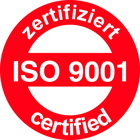Explosion protection classification
 Zones – Explosion groups – Temperature classes
Zones – Explosion groups – Temperature classes
Introduction
Explosion hazard areas are divided into zones, the equipment in device groups and device categories. For a certified device, the marking on the type plate makes it identifiable for which zone the explosion protected equipment may be used.
Classification into device groups
Devices are divided in Groups into I an d II, whereby Group I involves mining "underground" and Group II involves gas and dust explosion protection in all other applications.
d II, whereby Group I involves mining "underground" and Group II involves gas and dust explosion protection in all other applications.
Classification into zones
Explosion hazard areas are divided into six zones, whereby the division is determined by the probability of how often and long it is expected that a hazardous explosive atmosphere occurs. Combustible gases, mists, vapours and combustible dusts are distinguished.
Zones 0, 1 and 2 arise for gases-mists-vapours, whereby the requirements for the equipment used there ascend from zone 2 to 0.
Zones 20, 21 and 22 arise for dusts, whereby the requirements for the equipment used there ascend from zone 22 to 20.
Classification into ignition protection categories
The ignition protection type does not represent a quality feature, but is a constructive solution to achieve explosion protection for the equipment.
For electrical equipment in gas
- Intrinsic safety Ex i
- Pressure-proof enclosure Ex d
- Increased safety Ex e
- Pressurized enclosure Ex p
- Oil immersion Ex o
- Cast enclosure Ex m
- Powder filling Ex q
- Ignition protection for Zone 2 Ex n
- Special ignition protection Ex s
For non-electrical equipment
- Protection by flow restricting enclosure Ex fr
- Pressure-proof enclosure Ex d
- Intrinsic safety Ex g
- Constructional safety Ex c
- Ignition source monitoring Ex b
- Pressurized enclosure Ex p
- Liquid immersion Ex k
For electrical equipment in dust
- Pressurized enclosure Ex pD
- Intrinsic safety Ex iD
- Cast enclosure Ex mD
- Dust ignition protection Ex tD


Hillesheim  devices and heating systems are approved for gases in zone 1/2 and dusts in zone 21/22
devices and heating systems are approved for gases in zone 1/2 and dusts in zone 21/22
Classification into device categories
The device category defines which equipment may be used in which zone. In turn, there are six device categories. Categories 1G, 2G and 3G are classifications for gas explosion protection (G = gas); equipment with 1G is suitable for zone 0, 1 and 2, equipment with 2G for zone 1 and 2 and equipment with 3G for zone 2. The categories 1D, 2D and 3 D are classifications for dust explosion protection (D = dust); equipment with 1D is suitable for zone 20, 21 and 22, equipment with 2D for zone 21 and 22 equipment with 3D for zone 22.
Explosion groups, temperature classes
The device group and device category defines in which zones an item of equipment can be used. It is defined from the explosion group and temperature class for which media within the zones the equipment may be used.
Classification into explosion groups
Depending on the ignition type, the explosion protected equipment is sub-divided for gases, mists and vapours in three explosion groups (IIA-IIB-IIC). The explosion groups are split according to how flammable a gas is. The requirements for the equipment rise from II A to II C.
Classification in temperature classes
The explosion protected equipment installed within the explosion hazard area is divided in six temperature classes (T1 to T6). The temperature class is not - as it is often erroneously interpreted - the deployment temperature of the equipment, but rather the maximum permissible surface temperature on the equipment, which, in relation to an environmental temperature of + 40°C, must not be exceeded at any point on the surface at any time. The maximum surface temperature must always be lower than the ignition temperature of the surrounding medium. The requirements for the equipment rise from T1 to T6.









 deutsch
deutsch international
international